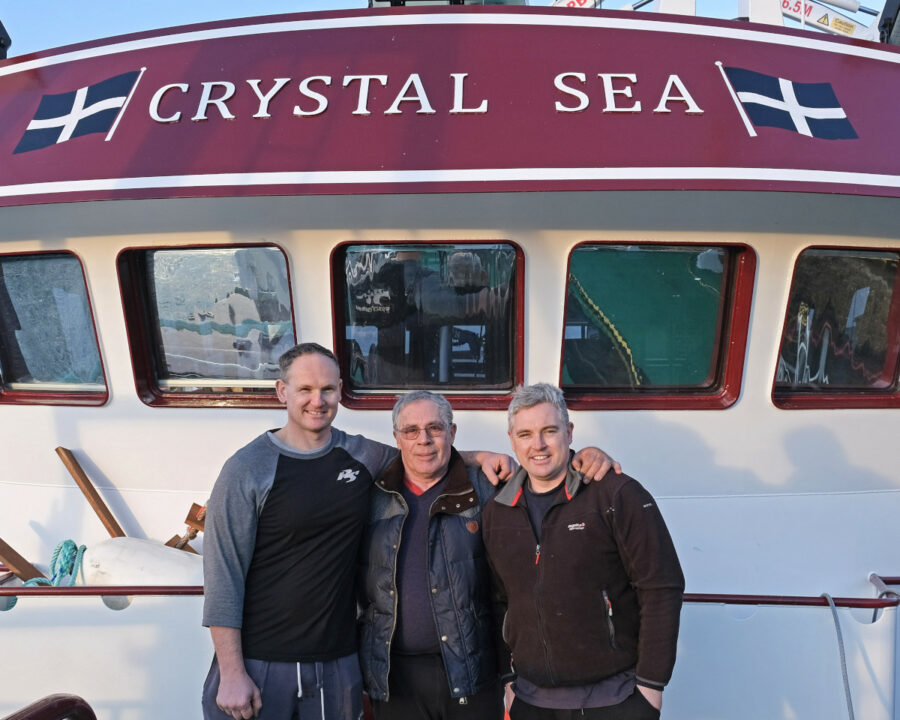St Ives family achieves long-cherished ambition by taking delivery of new boat from Macduff Shipyards
The new 24.5m twin-rig trawler Crystal Sea SS 118 started fishing from Newlyn towards the end of last month, under the shared command of St Ives brothers David and Alec Stevens, reports David Linkie
Crystal Sea’s arrival at Newlyn marks the fulfilment of a long-term goal spanning four decades for the Stevens family, going back to before skipper David Stevens Snr was joined on the first of four Crystal Seas by his sons David and Alec when they left school.
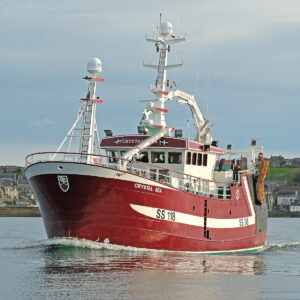
Crystal Sea features a new hull design and customised twin-rig trawling arrangements.
Since David Stevens bought the Macduff-built Crystal Sea BF 218 in 1989, the family has experienced an all-too-familiar pattern of peaks and troughs, which they met with steely determination and a strong desire to maintain their way of life.
In a period of continual challenges, there were three consistent underlying factors:
- The family’s strong links with
- Macduff Shipyards
- Restrictive quotas
- The increasing numbers
- of foreign trawlers fishing off
- Cornwall.
The first factor, which included the purchase in 2007 and again in 2016 of newer boats built by Macduff Shipyards, provided the stability for David and Alec Stevens, helped by their father working tirelessly ashore, to take the business forward, constantly striving to overcome the inevitable challenges and pressures associated with building a family business.

Crystal Sea skippers David and Alec Stevens with their father David Stevens.
With stock levels following a gradual welcome upward trend, Crystal Sea Fishing Ltd took the decision to order a new boat, recognising that it was now or never, and that there is no such thing as the right time to build, given the ever-changing and totally unpredictable nature of fishing.
Whatever the future holds post-Brexit, Crystal Sea’s arrival in Cornwall is particularly significant, as the vessel has the distinction of being the biggest new boat to be built for Newlyn since skipper Sidney Thomas took delivery of the 25.5m Girl Pat III PZ 87 in 1978.
Before Crystal Sea left Macduff, Peterhead skipper John Buchan, who led the Leave flotilla through Tower Bridge four long years ago, presented David and Alec Stevens with a lucky Brexit coin.
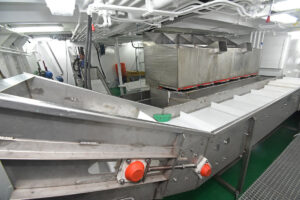
General view of the catch-handling arrangements.
The Stevens’ long association with Macduff Shipyards meant that the choice of yard was never in doubt.
Unsurprisingly, the 21.2m steel-hulled Crystal Sea, which was built at Macduff in 2008 as Rebecca FR 143 and moved to Newlyn four years ago, was used as a starting point for the new build, notwithstanding the fact that hull technology has advanced significantly in recent years.
As a result, Crystal Sea features a new design of hull, which evolved from the yard’s previous 24m models.
Of 24.5m LOA and with a longer keel, the design was developed to reduce hull resistance and therefore improve fuel efficiency and running speed. CFD technology was used at the first stage to measure the resistance of the new hull against previous designs, and to identify areas where further improvements could be made.

The wheelhouse interior.
Following this, the hull lines were faired by Macduff Ship Design, which then used the virtual model to produce a detailed set of kit construction plans and assess the stability. The kit was then cut in-house by Macduff Profilers, a division of the yard, and the vessel was fabricated, engineered and fully fitted out in the yard’s main building hall at Macduff.
The first hull modules started to be assembled in June, with Crystal Sea entering the water at Macduff in December, before running fishing trials towards the end of January. This exceptionally quick build programme resulted in Crystal Sea being handed over well in advance of the provisionally agreed time.

A spacious galley is situated aft of the messdeck on the starboard side of the deck casing.
On arrival at Newlyn after an extremely stormy passage along the east and south coasts of England, skipper David Stevens said: “As expected, from the outset the Macduff Shipyards team have been a real pleasure to work with. Whenever we suggested something, they were usually a couple of steps ahead of us, such is their level of experience.
“After performing well on fishing trials carried out in fine weather, Crystal Sea was well tested on the delivery trip home, when she more than proved her seakeeping qualities. We are delighted with Crystal Sea in every aspect. This has been a long journey in every sense, but the end fully justifies the bumps in the road along the way.
“In the wake of Brexit, if the government delivers a favourable outcome, the UK fleet stands on the cusp of what should be a considerably more encouraging future. The next year or so is hugely important to all fishermen and processors in the UK. Fishermen from Shetland to Cornwall continue to show their commitment to the future of our industry. Now is the time for government ministers to step up to the mark and give us the support we deserve.”
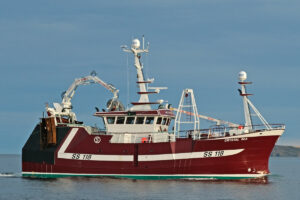
Crystal Sea is the biggest new whitefish vessel built for the Newlyn fleet for 42 years.
The fourth Crystal Sea to be insured by Sunderland Marine, the new vessel is expected to fish trips of six days’ duration, sailing on a Tuesday and returning the following Monday to Newlyn, from where catches will be trucked to Plymouth by Cornwall Transport for electronic auction by Plymouth Trawler Agents.
That Crystal Sea’s catches usually include between 25 and 30 different species shows the rich diversity of fish found on traditional grounds usually little more than 50 miles off Land’s End.
The use of long bridles to maximise herding effect ahead of the twin-rig groundfish scraper nets, supplied by Faithlie Trawl of Fraserburgh, has influenced gear-handling arrangements on Crystal Sea. Two sets of split sweep winches are positioned atop the shelterdeck, directly above the usual arrangement of split net drums on the quarter.
Crystal Sea is built completely from Lloyds grade A steel, apart from the aluminium wheelhouse and masts, and features a double chine hull form, a transom stern, and a soft nose bulbous bow which is faired gently into the main hull body.
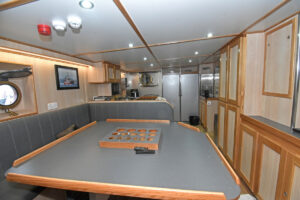
Crystal Sea’s superbly finished messdeck.
The twin-rig trawler has main dimensions of LOA 24.5m, registered length 22.78m, beam 7.60m, depth moulded 4.3m, draught 4.8m and GT 247t.
Before being rolled out of the fabrication hall, Crystal Sea was fully painted by the yard and Alexander Paterson, including distinctive Cornish flags displayed on the wheelhouse visor.
Below the main deck, from the transom Crystal Sea is arranged into four compartments: cabin, engineroom, fish hold and forepeak, in which a large freshwater tank is housed.
Under the full-length steel shelterdeck, which is formed as an extension of the hull without a gunwale rail, a watertight full-width deckhouse separates the weathertight catch-handling area forward from the net-handling area on the quarter. The connecting passageway in the deck casing is offset to the port rail.

The starboard side three-bed cabin.
An additional bulkhead is fitted forward on the main deck to create a dedicated winch room, in which three split trawl winches are housed.
An immaculately finished combined galley/messdeck extends the full length of the deckhouse on the starboard side. The usual range of electrical units in the galley were supplied by RD Downie of Fraserburgh which, as customary with all Macduff builds, wired Crystal Sea and manufactured the engineroom and wheelhouse electrical distribution cabinet boards.
Accessed from the port side passageway that connects the fish-handling area amidships directly to the quarter, the deckhouse also accommodates separate shower and toilet compartments, in addition to washing and tumble-drying appliances.
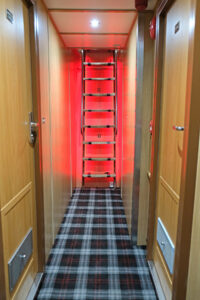
Low-level LED safety lighting is fitted on the internal stairs.
Incorporating bench seating, a wash basin and extensive locker storage, the spacious passageway also includes heated storage for the crew’s protective clothing. The survival suits and lifejackets, which are fitted with PLBs, came from Newlyn Chandlery, Newlyn.
Blue Anchor Fire and Safety Ltd of Fraserburgh supplied the vessel’s CO2 system, fire extinguishers, pyrotechnics and other general safety equipment.
Down the aft stair, an interesting layout effectively enables four separate cabins. A skipper’s cabin is arranged on the port side forward of another two bunks. A corridor situated abaft the compartment housing the Scan APS steering gear leads across the boat to three- and two-berth cabins on the starboard side.
Engineroom

Crystal Sea’s Cat C32 ACERT main engine…
Crystal Sea is powered by a Caterpillar C32 main engine supplied by Finning UK Ltd.
Developing 492kW @ 1,800rpm and solely dedicated to propulsion duties, the main engine drives a 2,500mm-diameter four-bladed fixed-pitch Wärtsilä propeller, turning in a new design of matching Wärtsilä fixed nozzle through a Masson 9.077:1 reduction gearbox.
The remaining stern gear elements were designed and manufactured by Macduff Engineering, a division of the yard, on CNC-operated machines. This is the fifth propulsion system of this design to be fitted by the yard, and has been noted to perform very well, operating smoothly and quietly and taking advantage of the C32 engine’s flexibility, which can help to extract full power while both steaming and trawling.
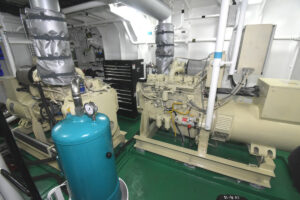
… and two Beta Marine gensets.
As is becoming relatively standard for the yard’s new builds, a triple rudder system is fitted. Over the years, these have proven to be popular with skippers, providing a high level of manoeuvrability and increasing the vessel’s ability to tow across the tide.
The centreline combination gave Crystal Sea an average top speed of 10.4 knots on sea trials in the Moray Firth. This provided immediate confirmation of the benefits of increasing the waterline length, as indicated by CFD testing during the design of the hull, allied to the efficiency of the chosen centreline machinery package.

A Caterpillar C12 variable-speed auxiliary engine drives Crystal Sea’s main hydraulic system…
A Caterpillar C12 variable-speed auxiliary engine (286kW @ 1,800rpm) mounted on the port tank top drives three Denison pumps for the deck machinery through a Brevini adaptor.
A back-up hydraulic net-retrieve system is powered by two electrically driven pump sets, each of 45kW and capable of running simultaneously if both Beta Marine generators are used. The hydraulic system was designed in-house by Macduff Shipyards to meet the specific requirements of the unique package of deck machinery installed on Crystal Sea.
Electrical supplies onboard Crystal Sea are provided by two Cummins 6BT5.9D2(M) engines (86kW @ 1,500rpm) driving 81.6kW 415/3/50 Mecc Alte generators. Supplied by Beta Marine, the electrical gensets will usually be run alternately.
Cooling for the four engines and the hydraulic system is provided through freshwater box coolers, supplied and fitted by Blokland Non Ferro and arranged across the forward end of the engineroom.
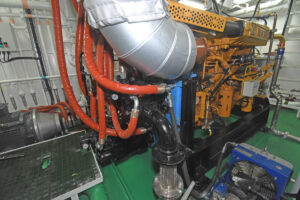
… through a Brevini adaptor unit and three Denison pumps.
Two electrically driven 150-amp Transmotor alternators provide 24V DC supplies to the four sets of batteries fitted – one for each engine and an emergency bank. A Victron 24V battery charger and inverter are also fitted.
The combination of the double-bottom tank, wing tank and daily service tank in the engineroom allow 21,028 litres of fuel to be carried. A large bulbous bow tank carries 25,425 litres of freshwater.
A T700 hydraulic bow thruster supplied by Hardy Engineering is fitted to give Crystal Sea maximum manoeuvrability when operating in restricted spaces.
‘A long but very worthwhile journey’
Every now and again, it’s worth reminding yourself of your journey, and why you do what you do.

Skipper David Stevens with the new Crystal Sea, ahead of the delivery trip from Macduff to Newlyn.
I have been fishing for 30 years this year, after starting in 1990 when I left school at 15 to join my dad on our family boat, the first Crystal Sea.
My brother Alec joined us two years later when he also left school early, as I had a bad accident and was unable to go to sea for nine months.
Since then, we have seen many changes. Back then, the fleet in Newlyn was twice, if not three times, the size it is now.
For those families who stayed in fishing, the mid to late nineties were tough times when we found ourselves having to work the boats and ourselves non-stop, just to keep our heads above water.
Turning the corner
Following successive decommissioning schemes in the early 2000s, things gradually started to turn around, when fishing slowly improved as a result of fewer UK boats on the grounds. As returns became more financially viable, we took the decision to start investing in the future, as Alec and I were in our early 20s, and we were determined to stay fishing.
We knew that where we worked, west of the Lizard Point, a 20m-plus boat was required to work all year round, due to the area’s exposed position off the southwestern tip of Cornwall.
The old saying, you can’t put the cart before the horse, is true. To go on fishing, you needed to invest, so we bought quota. The quota situation was tight; every year the quotas went down, but the fishing was improving, so we had little choice.
We tried to keep up with the maintenance of the vessel as best we could, but eventually we got to the point when we needed a newer boat.
So we headed back up to Scotland in October 2007, when we purchased Good Design from Colin Mitchell and Stephen West.
In this vessel, we were able to twin-rig for whitefish. We had seen our friends Stephen and Gary Leach in the Wayfarer SS 252 do well at mixed whitefish and prawns.
For us, it was a success, and it proved that a trawler could compete with beam trawling for catching groundfish.
After working that vessel for just under nine years, we decided that steel was the way to go for us, so we purchased the next Crystal Sea from Adam Tait and family in March 2016.
We were lucky to get hold of this boat, Rebecca FR 143, which was in great condition and still very modern.
The experience we gained in working a modern steel vessel helped us a lot, and gave us a great insight into how to set up a steel boat when we came to build our first boat for 50 years, since the Rose of Sharon FR 23 was built at Forbes of Sandhaven.
Lifetime ambition achieved
So, after 30 years of what was never a certain future, we finally got to build our own family boat – a dream Alec and I had shared from leaving school.
In all of the years we have been fishing, we have been in contact with Macduff Shipyards, relying on the company’s expertise and its great stores, which stock pretty much everything you need to run a fishing business.
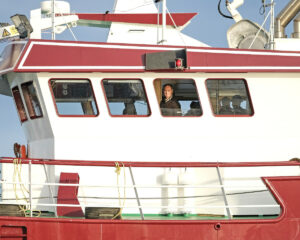
Skipper David Stevens takes Crystal Sea to sea for the first time, achieving a long-cherished family ambition.
For us, Macduff Shipyards was the only place to build our vessel, as our three previous boats were all built at Macduff and served us well, as has the yard team over the years.
As a family business, we would like to take this opportunity to thank all of the Macduff Shipyards’ team for everything they have done over the years, and for building us a very fine boat.
Living in Cornwall, 750 miles from Macduff, it was never going to be easy building a boat so far away, but the yard’s team made it so much easier.
They have so much experience building these types of boats, that everything you could think of was done, and more. Anything we wanted different to suit our way of working was fitted and was never a problem to do. Even trying to get ideas across by email or phone was not an issue, and when we came to visit, it was always what we had asked for, and spot-on.
The workmanship, design and build quality are second to none; they really are master tradesmen.
We have been to Scotland many times over the years, visiting the harbours looking at boats, and having a major refit or two carried out in Macduff. Alec and I both took our skipper’s tickets at Banff and Buchan College in the Broch.
We have always admired how the Scottish industry moves on and invests in new boats, and drives the UK fishing industry forward – it really is the engine of the UK fishing industry.
It was great to be back in Scotland building the boat from May last year. We would spend 48 hours travelling up and down from Cornwall to Scotland every two weeks to oversee the build, catching up with the yard as often as we could.
When we travelled up early in January to spend the last five weeks of the build in Macduff, we were kept busy with the preparations on the boat, but had time to catch up with family friends we had made over the course of years and generations.
That, to us as a family and to all of us involved in the UK fishing industry, is the best part of the job (apart from good hauls of fish) – the camaraderie between friends and fishing families.
We had a great time catching up with fellow fishermen – who’s building or thinking about building, which boats are for sale, who’s buying what – and learning about the latest ideas and incorporating them into the boat.
Those links go back many years. The family connections that the UK has maintained have served the UK fishing industry well.
The course we have all had to travel has been driven by pure political streamlining and economics over the past 30 years. It’s the family businesses, that have struggled through by pulling together and helping each other along the way, that have kept the UK fishing industry together.
Home run
We did sea trials for the new vessel in fine weather in the Moray Firth, when all went well and the yard team were on hand to help us get used to the boat. We also had a lot of help from local fishermen giving us information on where to start, particularly Rob Souter off the Fisher Boys.
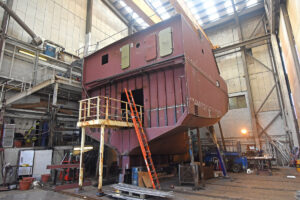
A lifetime’s ambition starts to become a reality as Crystal Sea takes shape in Macduff Shipyards’ fabrication hall seven months ago.
The boat performed well, and at present, she seems to be 10% more efficient on towing and steaming for the same fuel.
We passed the last of the DTI work on 6 February, then left the next morning, after going to the design office of Macduff Shipyards to wish the team well. They handed us a brown envelope. We asked: “What’s that?” In typically understated Macduff style, they said: “That’s it – she’s yours now.” That was a good moment.
As we all know, the Macduff team deliver their message in great workmanship and commitment to our industry, pushing design and engineering forward.
We left the Moray Firth on the afternoon of 7 February, turned into a southerly gale off Rattray Head and made our way down the Buchan coast past Fraserburgh and Peterhead.
It was a poor run down past the Bell Rock towards the Forth, with winds of 50 knots most of the way, but the boat handled the weather well, kept her head down and cut the waves cleanly.
The forecast was storm force over the next few days from Storm Ciara, so we decided to make our way into the Tyne on Saturday evening to lie over in North Shields, rather than head any further down the coast, to avoid meeting storm conditions in the English Channel.
We had great advice from the local guys on how to handle the strong tides in the river with southerly storm-force winds. My old pal Ned Clark even came out in the evening in pouring rain to see us in and take the ropes.
After quite a few visitors had come aboard to wish us well, we headed out again 36 hours later, early on Monday morning, to make our way down the rest of the North Sea.
It was still a very poor forecast, so we kept close to the coast. With it being westerly, it was fine. It was great catching up with different fishermen as we passed their ports along the way via social media.
We made it into the English Channel just as Dover opened its harbour again after the storm; it was a bumpy ride, but slowly improved.
Fortunately, we passed the Isle of Wight with the tide, but met another nasty blow crossing Portland Bill into Lyme Bay, so we called into Brixham for a few hours to get the tide right at Start Point.
My father then joined us for the last leg home, which was a great moment. All through the build he has been a huge help to us, helping to oversee the build and giving us that extra experienced older pair of eyes on the task.
We had more visits from old friends in Brixham, before we left to round the Start for the last dozen hours to Newlyn. There we were welcomed by family members and friends before enjoying a traditional Cornish cakey tea, followed by a small naming ceremony in the evening.
The delivery trip took just under a week, with poor conditions and stopovers holding us up for three days, but to have the level of support we experienced as we passed along the coast to our home port was a great feeling. How many industries have that across the UK? Fishing is quite unique in that way.
Building the boat has been a great experience, one of the best of my life, and to do it with my family has made it a very special time for us all.
I am very grateful to be part of something far bigger than just a job. It’s our way of life, and being part of the UK fishing industry is a privilege.
I’d like to thank the many people who have helped us over the years within the industry, and those who support the industry. Without them and that community, who knows where any of us would be?
Independent coastal state status
When we look at our European partners, they have had subsidies thrown at them, huge government support and intervention, soft loans and grants for everything, and access to the UK’s fishing grounds to do it.
But in most cases, they have lost that family business connection – it’s largely a company-based industry.
As an industry, we have had to make room for other member states to fish our waters, seen our share of fishing rights given away in successive treaties, been robbed of rights, most notably the west of Scotland deep-water fishery, handed to the French over a dubious reference period, as they had the presidency at the time.
We have abided by the rules, then watched our vessels pushed off our own grounds by Spanish or French fisherman, or seen our grounds decimated by pulse fishing and uncontrolled effort by some member states.
When we dared to fish perfectly legally in another member state’s waters for scallops, we witnessed our fleet being once again hounded out of the grounds.
However, through all of this the backbone of the UK fishing industry has fought on and survived. We are a far smaller fleet than we have ever been, but the lack of intervention has led us to be economically independent and innovative.
The prize for us as an industry, after witnessing all we have, is gaining independent coastal state status – quite simply, being solely responsible for our own future, without the intervention of the disastrous CFP.
Back in late 2015, we all dared to hope that the referendum would go our way and deliver the result we dreamed of: independence.
The only industry which turned out in full force was the UK fishing industry, led by my friend John Buchan on the Peterhead stern trawler Atlantic Challenge, leading the flotilla up the Thames.
What a moment for our industry! I remember watching the Andrew Neil show – bored by the day’s dull parliament, he said: “There’s something more interesting happening on the Thames.” Cue Geldof and the London elite drunks, on a gin palace, shouting ignorant abuse at committed fishermen who had suffered for years at the hands of the CFP. We were united in what we wanted. Over 90% of us voted to leave, and boy, do we have good reason.
The outcome is now clear. Yes, it’s an uncertain time to build, but any time in the past 30 years has been uncertain. Without doubt, different challenges lie ahead, but whatever happens, at least the prospect of the UK controlling its own waters looks certain.
I hope to see a move back to communities benefiting from the sea, with repatriated quota being community-based, to support local vessels and keep communities fishing.
I hope the UK leads the way on a fishery based on a co-management approach, making use of our scientific community, working with industry and government, to gather the data to run a world-class industry.
I don’t see a UK vessel-only fishery in our waters (unless we fail to reach agreement), but I certainly want to see a fairer deal that gives UK fishermen greater access to their own waters than foreign counterparts.
Also, there are clear wrongs that need addressing: Channel quota shares, west of Scotland deep-water shares, foreign effort off Shetland and the southwest of the UK, economic links, the pulse fishery off the Thames and the southern North Sea.
We have to use the greatest prize – the access card – carefully. It may very well need playing, at some point. The industry’s greatest fear is market access being denied due to the other member states not accepting the new arrangements. But whether it is a WTO or a negotiated deal with trade, we have the law on our side, and I’d urge the government to hold access to UK waters against any funny business by the EU member states on fish trade.
Wheelhouse electronics from Woodsons and Furuno UK
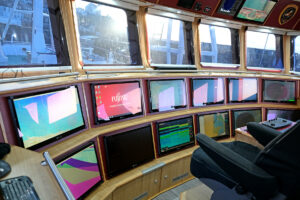
Display screens are arranged in two tiers in the main forward console.
The comprehensive array of electronics equipment installed in Crystal Sea’s wheelhouse was supplied and commissioned by Woodsons of Aberdeen. SIRM UK’s Newlyn branch and Furuno UK Ltd also supplied bottom-sounding and plotting units.
Five Neovo X24 wide-screen displays and seven Neovo X19 units are flush-mounted over two levels in the main forward console and at the wide U-shaped fishing console situated to starboard aft, which provides a commanding view of hauling and shooting activities across the stern.
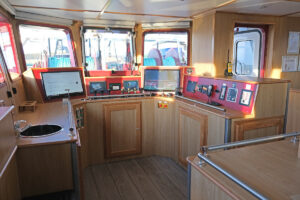
The fishing console is arranged in the aft starboard corner of the wheelhouse.
Two NorSap seats flank a small central console, on which the controls for the autopilot and radar sets are mounted.
Including an office area and tea/coffee-making facilities, the spacious wheelhouse is finished to the exemplary high standards for which the Macduff Shipyards team is renowned.
Bottom-sounding and fish-detection duties onboard Crystal Sea are handled by a JRC JFC-1800 BB single-frequency (38Hz) echosounder and a WASSP F3i (160kHz) multibeam sounder. The multibeam unit provides seabed mapping and real-time ground hardness, enabling skippers Alec and David Stevens to quickly build up an accurate 3D representation of the bottom they are fishing, so that the twin-rig gear can be towed tight to small peaks and ground edges where fish could be lying.
Information from the WASSP is displayed through the MaxSea TimeZero chart plotter, which also came from Furuno UK.
Olex 3D (Woodsons) and Sodena Easywin (SIRM UK) plotting systems support the customary combination of AIS, ARPA, tides and charts.
Two Furuno GP39 GPS navigators process details of Crystal Sea’s location, and vessel heading is provided via a JRC JLR 21 satellite compass.
Crystal Sea’s main radar is a JRC JMA 53126 BB unit, backed up by a JRC JMA-3334 set.
Steering is handled by a Navitron NT921G MKII autopilot system complete with three steering tillers and rudder indicators.
Communications and safety equipment includes a JRC JSS-2150 150W GMDSS MF/HF radio telephone, Icom and Entel VHFs, JRC Navtex, Jotron TR-8000 Class A AIS, Jotron TRON 60 GPS EPIRB, and eSEA 60Ka internet communication and eSEA 80 satellite TV systems.
Installed by Woodsons, the vessel’s CCTV system features images from nine strategically located cameras, in addition to an underwater camera monitoring the propeller and rudder.
Customised trawling arrangements
Crystal Sea is equipped with a customised deck machinery package, most of which was manufactured by Macduff Shipyards.

Eighty fathoms of 42mm-diameter four-strand combination warp are worked from split sweepline winches aft on the shelterdeck.
After discussing various options based on drum capacity (wire and sweeps), flexibility and practicality, the owners opted for split trawl and sweep winches – a first for the yard on this class of vessel.
Three split trawl winches are positioned forward on the main deck in a separate winch room. These are rated 15t core pull and fitted with Hägglunds two-speed drive motors for faster hauling and shooting.
Spooled with 275 fathoms of 24mm-diameter fibre-core wire sourced from MarineCo, South Devon, the middle wire winch is centrally positioned forward of the two outer winches, which carry 22mm-diameter wire.
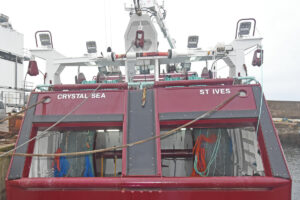
Twin-rig trawling arrangements across Crystal Sea’s transom.
Angled upwards from the drums at some 35° to hooded rollers, the outer wires run across the top of the shelterdeck to a second set of sheaves positioned near the forward corners of the wheelhouse, from where they are directed upwards and outwards towards hanging blocks mounted on a conventional trawl gantry.
The middle wire runs under the wheelhouse floor, before leading upwards to pass through a central opening in the trawl gantry to a hanging block mounted on the underside of the raised saddle on which the powerblock crane is mounted, directly above a secure track for the safe storage of the middle roller.
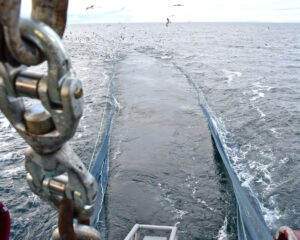
Hauling the twin-rig trawls for the first time on fishing trials in the Moray Firth.
The split trawl winches are operated from a control panel built into the fishing console in the wheelhouse, from which the skippers have full sight of the trawl doors and clump coming up to the blocks.
When towing, the outer wires are chained up to a free-running slewing block on a short strop attached to swivel blocks mounted either side on the aft face of the trawl gantry – an arrangement commonly referred to as a ‘poor man’s autotrawl’. The middle wire is worked directly off the winch drum, enabling the skipper to adjust the length when required, depending on the spread of the gear being shown by the Simrad PX twin-rig Geometry net-monitoring system.
Two sets of 2 x 8t split net drums are arranged side by side on the non-watertight wooden-decked quarter, in line with the customary transom shooting and hauling hatches, the lower edges of which are fitted with free-turning large-diameter rollers.
Two sets of 2 x 8t split sweepline winches are mounted atop the shelterdeck. Four x 80 fathoms of 42mm four-strand combination warp are worked over a free-running roller mounted atop the transom rail, into which guide-on pins are placed.
MacGregor (Rapp) manufactured the RPBC 14 kinked-boom short-post crane and tilting 24in powerblock, which is centrally fitted atop the trawl gantry.
Faithlie Trawl supplies heavy-duty all-round nets
Crystal Sea’s twin-rig nets came from Faithlie Trawl of Fraserburgh, which recently became the largest independent net-maker.
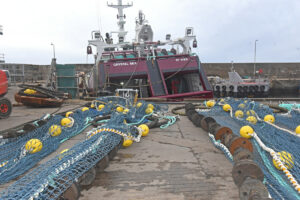
New heavy-duty twin-rig fish scraper nets made by Faithlie Trawl, ready to be pulled onboard Crystal Sea.
The consistently successful results achieved using Faithlie twin-rig trawls on their previous boats meant that skippers David and Alec Stevens had no hesitation in asking Willie Hepburn and his team to make trawls for their new vessel.
Targeting an extremely mixed fishery of ground and gadoid species on fairly hard bottom, Crystal Sea tows custom-designed heavy-duty nets.
In addition to a set of nearly new 171ft fish nets rigged on 8in and 10in discs that performed well on the previous boat, Crystal Sea is also towing a new style of 190ft nets set on 150ft of 8in and 10in discs.
This will enable skippers David and Alec Stevens to compare the two sets of twin-rig trawls in the coming weeks, before Faithlie Trawl makes a new second set of nets for Crystal Sea.
The twin-rig trawls are worked in combination with 80 fathoms of 42mm-diameter four-strand combination sweeps made up by MarineCo. The South Devon company also supplied 3 x 275-fathom lengths of 22mm- and 24mm-diameter fibre-core trawl wires. The trawl wires and combination sweeps were transhipped to Scotland by Dennis Oates & Sons.
The twin-rig trawls are spread by a set of Thyborøn semi-pelagic Blue Stream Type 22 trawl doors with a high-standing surface area of 3m2 and weighing 840kg, and a 1,150kg middle roller manufactured by Macduff Shipyards.
New Crystal Sea further strengthens bonds between St Ives and Macduff
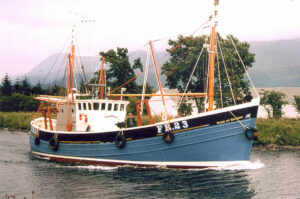
David and Alec Stevens’ grandfather Ernest Stevens took delivery of the 66ft trawler/longliner Rose of Sharon from Forbes of Sandhaven in 1969.
It could almost be said that taking delivery of their new boat from Macduff Shipyards was written in the stars, given that skippers David and Alec Stevens have been associated with the Macduff team throughout their fishing careers.
The association between the St Ives family owners and Macduff began before the brothers went to sea, when their father David Stevens bought the 21.5m wooden-hulled Crystal Sea BF 218 from Albert Watt of Macduff in 1989. Powered by a 373kW Kelvin engine, Crystal Sea was built by the Macduff Boat Building and Engineering Company in 1974. Originally open-decked, this boat was later fitted with a three-quarter-length shelterdeck, when a new raised wheelhouse was also fitted.
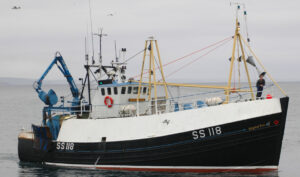
The first Crystal Sea…
The Stevens family’s connections with northeast Scotland predate Crystal Sea by 20 years, going back to 1969 when Forbes of Sandhaven built the 66ft trawler/longliner Rose of Sharon FR 23 for Ernest Stevens and his sons David, Paul and Peter. David Stevens went on to skipper Rose of Sharon between 1971 and 1977.
After fishing from Newlyn for 18 years as Crystal Sea SS 118 before being renamed Crystal SS 18, the single-rig trawler was bought by Robert and Charles Olsen of Gothenburg, and renamed Ferder after a well-known lighthouse in Sweden, in 2007.
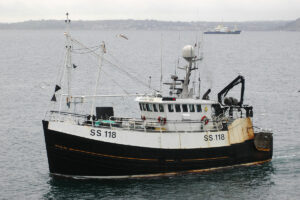
… was replaced in 2007 by the former Fraserburgh twin-rig trawler Good Design BF 151.
Her replacement was the 21m twin-rig trawler Good Design BF 151, which was renamed Crystal Sea SS 118 before leaving Fraserburgh for Cornwall.
Powered by a 399kW Caterpillar 3412 TA main engine, the second Crystal Sea was built by Macduff Shipyards in 1989 as the whitefish trawler Endeavour BF 326 for Whitehills skipper Peter Lovie. After fishing from Kinlochbervie for 10 years, during which time Endeavour was renamed Enterprise BF 1 by James Lovie, the trawler moved to Fraserburgh in 1999.
When Crystal Sea was bought by Gairloch skipper Angus Macleod and renamed Fladda Maid UL 209 in March 2016, the Stevens family returned to Macduff to purchase the 21.2m steel-hulled twin-rig trawler Rebecca FR 143 from Fraserburgh skipper Adam Tait.
Built by Macduff Shipyards in 2008, the Caterpillar C32-engined boat was renamed Vellee N 393 last month after being sold to Leestlin Trawlers (Fishing News, 13 February).
Catch-handling arrangements
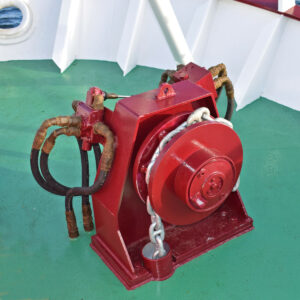
Secured at the starboard bow, Crystal Sea’s anchor is served by a dedicated anchor…
The codends are taken aboard forward on the starboard side by a MacGregor 5t Gilson winch serving a square-framed lifting gantry arranged over a hydraulically operated hatch and a large-capacity reception hopper, capable of holding over 200 boxes of whitefish.
The layout and working arrangements in the catch-handing area forward of the deck casing are customised to the owners’ specific requirements.

… with the chain stored in the forepeak locker.
A fully integrated aluminium and stainless steel fish-handling system, designed and fabricated by Macduff Shipyards to enhance catch quality while reducing the crew’s workload, lies at the heart of the working arrangements.
A transverse conveyor lifts catches from the base of the hopper and across the full beam of the vessel. After being selected and gutted, the main selections of fish are placed in one of two banks of six elevated selection hoppers available. When full, the contents are released directly downwards into one of three integrated washers and then into a secondary washer to port. After being cleaned, the selections flow on to a second conveyor positioned towards the port side, for delivery to the fishroom for weighing and boxing.
When Crystal Sea is engaged in a heavier directed fishery, species like round haddock are routed to the main washer by a trough positioned between the main transverse conveyor and the elevated reception bins.
Monkfish are taken off the conveyor and placed in a trough on the starboard side before being tailed on a dedicated table.
Cuttles and squid are put into one of two square-section chutes that pass through the elevated bins before dropping into baskets securely held on plates on the foreside of the selection bins.
Further evidence of the wide range of species that Crystal Sea is expected to catch comes in the form of a stainless steel lidded crab tank, in which some 400kg of brown and spider crab can be stored in seawater.
The catch-handling area is kept free of excess water from the fish washers by two deck sumps drained by electrically driven Azcue pumps.
On delivery to the port side of the fishroom, catches are electronically weighed, with part-basket weights stored on the vessel’s VCU catch management system, before a label displaying all relevant information, including species, grade, size, time and date, is printed off and affixed to the end of the corresponding box. This information is also transferred automatically to a PC in the wheelhouse, where it is accumulated to provide a running total of Crystal Sea’s trips.
The vessel’s fishroom has a working capacity of 700 boxes. Up to 5t of flake ice can be stored in a full-height locker on the starboard side, directly under the 2.5t Geneglace flake ice machine housed in the dedicated refrigeration plant room on the main deck.
In order to enhance crew safety at all times, an easy-access ladder leads to the fishroom from the refrigeration room.
The fishroom chilling system, which uses 22mm-diameter stainless steel refrigeration pipes mounted on the deckhead, and stainless steel-sheathed copper piping on the engineroom bulkhead, was installed by Premier Refrigeration Ltd of Fraserburgh.
When landing, a small Gilson mounted on the underside of the shelterdeck is used to pull stacks of boxes forward to the centre of the fishroom, from where they are lifted ashore through a large hatch by a MacGregor RLC 8 stiff-boom crane served by a 2t landing winch.

